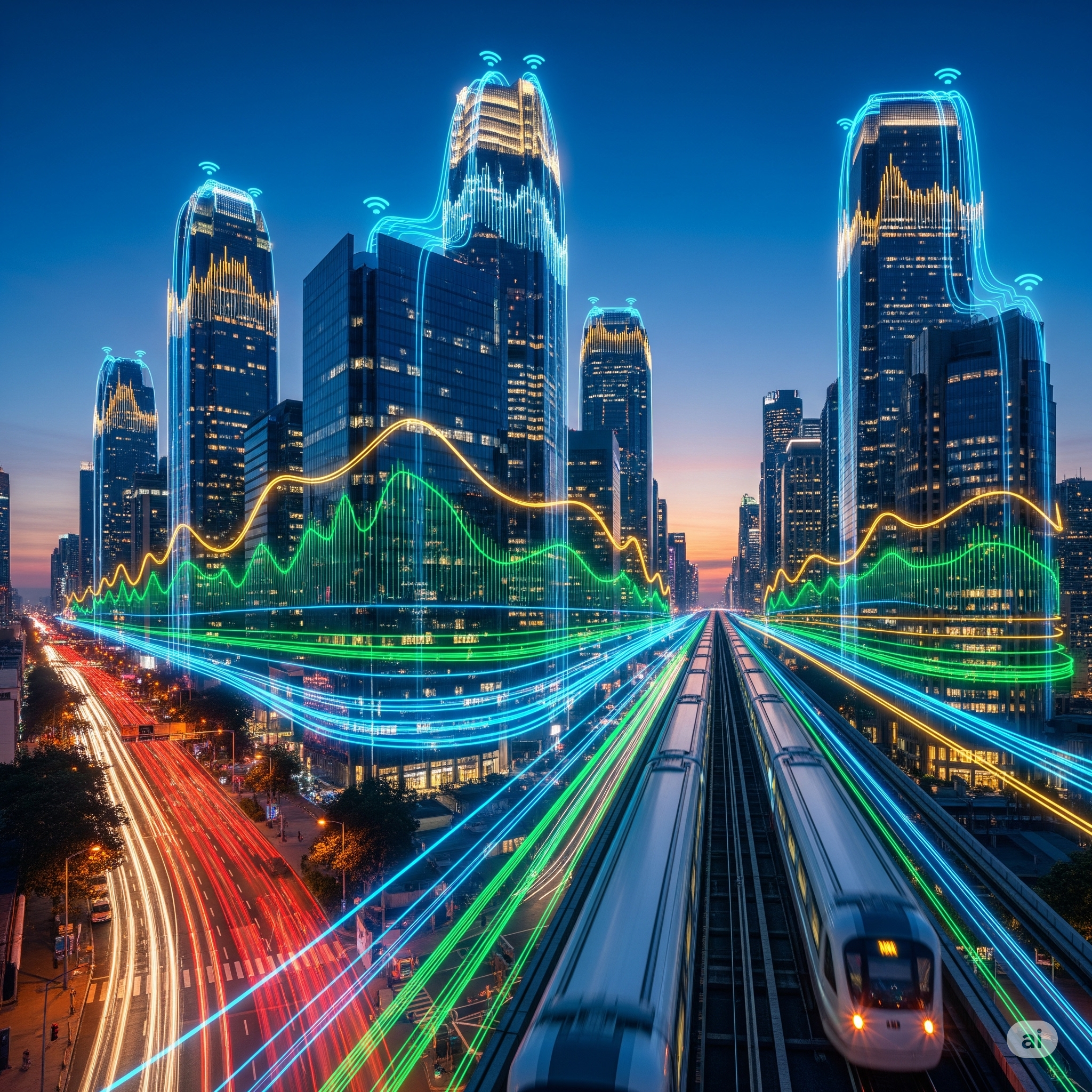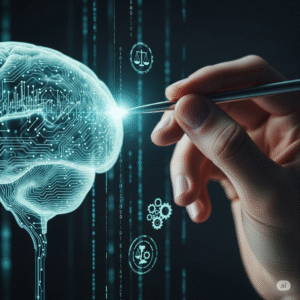Imagine a city that breathes, anticipates your needs, and operates with seamless efficiency. Traffic flows smoothly, energy is used optimally, and public services are readily available exactly when and where they’re needed. This isn’t a utopian fantasy; it’s the rapidly evolving reality of AI smart cities. Artificial intelligence is no longer confined to the digital realm; it’s physically reshaping our urban landscapes, transforming how we live, work, and interact within our communities.
For decades, urban planning has relied on traditional methods: surveys, historical data, and expert projections. While these approaches have yielded progress, they often struggle to keep pace with the dynamic complexities of modern urban life. This is where the transformative power of AI smart cities comes into play. By leveraging vast amounts of real-time data and sophisticated algorithms, urban planning AI is enabling a new era of data-driven decision-making, leading to more sustainable, resilient, and livable urban environments. This article will delve into the exciting world of AI smart cities, exploring their current applications, the benefits they offer, the challenges they present, and the tools that are making this intelligent urban future a tangible reality.
Decoding the Smart: What Makes a City Intelligent with AI?
The concept of a “smart city” has been around for some time, often associated with interconnected technology and data collection. However, the integration of artificial intelligence is the critical catalyst that elevates a connected city to a truly intelligent one. AI smart cities utilize AI algorithms to analyze the vast streams of data generated by urban sensors, devices, and systems. This analysis yields valuable insights that inform real-time adjustments and long-term planning across various urban domains.
Think of urban planning AI as the central nervous system of the city, constantly monitoring, interpreting, and reacting to the needs of its inhabitants and infrastructure. From optimizing traffic flow based on live congestion data to predicting energy demand and adjusting supply accordingly, AI smart cities are about creating urban ecosystems that are not just reactive but also proactive and adaptive.
The Core Components of AI Smart Cities
Several key technologies and principles underpin the functionality of AI smart cities:
- Internet of Things (IoT): A network of physical devices, vehicles, buildings, and other items embedded with sensors, software, and connectivity which enables these objects to collect and exchange data. This provides the raw information that
urban planning AIsystems analyze. - Big Data Analytics: The ability to process and analyze extremely large and complex datasets to uncover trends, patterns, and correlations. AI algorithms are essential for making sense of the sheer volume of data generated in a smart city.
- Artificial Intelligence (AI) and Machine Learning (ML): The core intelligence that drives decision-making. ML algorithms learn from data, allowing AI smart cities to continuously improve their performance over time.
- Cloud Computing: Provides the scalable infrastructure needed to store and process the massive amounts of data generated and analyzed by
government AIapplications in urban settings.
A successful AI smart cities initiative relies on the seamless integration of these components, guided by a clear vision and a robust ethical framework.
Beyond Efficiency: The Human-Centric Approach to AI Smart Cities
While efficiency and optimization are key goals of AI smart cities, the ultimate aim is to enhance the quality of life for urban dwellers. This human-centric approach ensures that technology serves the needs of the people, creating cities that are not just smarter but also more sustainable, inclusive, and enjoyable to live in. Urban planning AI can contribute to this by:
- Improving Public Safety: AI-powered surveillance systems can detect anomalies and alert authorities, while predictive policing algorithms (used ethically and with proper oversight) can help allocate resources to prevent crime.
- Enhancing Mobility: Intelligent traffic management systems reduce congestion, while AI-powered public transportation can optimize routes and schedules based on real-time demand.
- Promoting Sustainability: Smart grids optimize energy consumption, AI-powered waste management systems improve recycling rates, and environmental monitoring through IoT sensors provides data for informed policy decisions.
- Improving Accessibility: AI can help personalize public services and information delivery to meet the diverse needs of urban populations, including those with disabilities.
The development of AI smart cities must prioritize the well-being and needs of citizens, ensuring that technological advancements translate into tangible improvements in their daily lives.
Smart Moves: How AI is Transforming Urban Planning and Infrastructure
The integration of AI is revolutionizing various aspects of urban planning and infrastructure management. From the initial stages of design and development to the ongoing maintenance and optimization of city systems, AI smart cities are leveraging data-driven insights to build more resilient and efficient urban environments.
AI-Powered Urban Planning and Design
Urban planning AI tools are assisting city planners in making more informed decisions about land use, zoning, and infrastructure development. By analyzing data on population growth, demographics, transportation patterns, and environmental factors, AI algorithms can generate simulations and models that help planners visualize the potential impact of different development scenarios. This allows for more strategic and sustainable urban growth, optimizing resource allocation and minimizing negative environmental consequences. For example, AI can help identify optimal locations for new public transportation hubs or predict the impact of new construction on traffic flow.
Intelligent Transportation Systems: The AI Highway
One of the most visible applications of AI smart cities is in transportation. AI-powered systems are optimizing traffic flow through dynamic traffic light control, predicting and managing congestion, and enabling the development of autonomous vehicles. Smart parking systems use sensors and AI to guide drivers to available parking spaces, reducing search times and traffic. Public transportation is also becoming more efficient with AI analyzing ridership patterns to optimize routes and schedules, leading to reduced wait times and improved service reliability. Companies like Zapier demonstrate the power of automation and integration, principles that are also central to intelligent transportation systems.
Smart Energy Grids and Sustainable Infrastructure
AI smart cities are at the forefront of creating more sustainable urban environments. AI algorithms can analyze energy consumption patterns to optimize the distribution of electricity, reduce waste, and integrate renewable energy sources more effectively. Smart grids use predictive analytics to anticipate energy demand and adjust supply accordingly, improving efficiency and reliability. AI also plays a role in optimizing water management, detecting leaks, and ensuring the efficient use of resources. Furthermore, AI-powered waste management systems can optimize collection routes and improve recycling processes, contributing to a more circular economy within the city.
Real-World Intelligence: Case Studies of AI Smart Cities in Action
Across the globe, pioneering cities are demonstrating the transformative potential of AI smart cities. These real-world examples offer valuable insights into the practical applications and benefits of urban planning AI.
Case Study 1: Barcelona’s Smart City Initiatives Barcelona has emerged as a leading example of an AI smart cities. The city has implemented a wide range of AI-powered initiatives, including smart lighting that adjusts brightness based on pedestrian presence, intelligent waste management systems that optimize collection routes based on fill levels, and smart parking that guides drivers to available spots. These interconnected systems are managed through a central platform, providing city officials with real-time data and insights that inform decision-making and improve the efficiency of municipal services. Barcelona’s approach highlights the importance of a holistic and integrated AI smart cities strategy.
Case Study 2: Singapore’s Smart Nation Vision Singapore’s “Smart Nation” initiative is a comprehensive national strategy aimed at leveraging technology, including AI, to improve all aspects of urban living. Key projects include AI-powered traffic management systems that optimize traffic flow and reduce congestion, predictive analytics for public health to detect and prevent disease outbreaks, and smart sensors that monitor air and water quality. Singapore’s commitment to data-driven governance and its proactive approach to addressing urban challenges through urban planning AI serve as a model for other cities around the world. The emphasis on ethical considerations and data privacy is also a crucial aspect of their AI smart cities strategy.
Navigating the Challenges: Ethical Considerations and the Future of AI Smart Cities
While the potential benefits of AI smart cities are significant, it’s crucial to acknowledge and address the inherent challenges and ethical considerations. Issues such as data privacy, algorithmic bias, cybersecurity risks, and the potential for increased social inequalities must be carefully considered and mitigated through thoughtful AI smart cities policies and regulations.
Data Privacy and Security in Intelligent Urban Environments
The vast amounts of data collected in AI smart cities raise significant concerns about privacy and security. It’s essential to establish clear guidelines and regulations regarding data collection, storage, and usage. Anonymization techniques and robust cybersecurity measures are crucial to protect citizen data from misuse and cyber threats. Transparency about how data is being used is also vital to maintain public trust in urban planning AI initiatives.
Algorithmic Bias and Ensuring Equity in AI Smart Cities
AI algorithms are trained on data, and if that data reflects existing societal biases, the AI systems can perpetuate and even amplify those biases. In the context of AI smart cities, this could lead to discriminatory outcomes in areas such as resource allocation or public safety. It’s crucial to proactively identify and mitigate bias in AI algorithms through careful data selection, rigorous testing, and ongoing monitoring. Ensuring equity and fairness in the deployment of urban planning AI is paramount. Resources from organizations like HubSpot on ethical AI development can provide valuable guidance.
Building the Future: Tools and Workflows for AI in Urban Planning
For urban planners and city administrators looking to embark on the journey of creating AI smart cities, a range of tools and established workflows can provide a solid foundation.
Key AI Tools for Urban Data Analysis and Planning
Several readily available AI-powered tools can assist in analyzing urban data and informing planning decisions:
- Geographic Information Systems (GIS) with AI Extensions: Modern GIS platforms are increasingly integrating AI and machine learning capabilities for spatial data analysis, predictive modeling, and visualization, aiding in
urban planning AI. - Data Visualization Platforms (e.g., Tableau, Power BI): These tools can help urban planners explore and communicate complex datasets related to transportation, energy consumption, and demographics in visually compelling ways, supporting data-driven decision-making in AI smart cities.
- AI-powered Simulation Software: Advanced simulation tools utilize AI algorithms to model urban systems, allowing planners to test different scenarios and predict the impact of various interventions before implementation.
- Natural Language Processing (NLP) Tools (e.g., MonkeyLearn): NLP can be used to analyze public feedback from surveys, social media, and other sources, providing valuable insights into citizen needs and preferences for
urban planning AIinitiatives.
A Practical Workflow for Implementing AI in Urban Planning
A step-by-step approach can help cities effectively integrate AI into their planning processes for AI smart cities:
- Identify a Specific Urban Challenge: Focus on a concrete problem that could benefit from AI, such as traffic congestion in a particular area or inefficient energy consumption in public buildings.
- Collect and Prepare Relevant Data: Gather the necessary data from existing sensors, databases, or other sources. Ensure the data is clean, accurate, and properly formatted for analysis.
- Select the Appropriate AI Tool or Technique: Based on the nature of the problem and the available data, choose the AI tool or algorithm that is best suited for the task (e.g., predictive modeling for traffic flow forecasting).
- Develop and Train the AI Model: If necessary, develop and train an AI model using the prepared data. This may require collaboration with data scientists or AI experts.
- Deploy and Integrate the AI Solution: Integrate the trained AI model into the relevant urban system or platform (e.g., a traffic management system or a building energy management system).
- Monitor Performance and Iterate: Continuously monitor the performance of the AI-powered solution, collect feedback, and make adjustments and improvements as needed. This iterative process is crucial for the ongoing success of AI smart cities initiatives.
The Horizon of Intelligent Urbanism: What the Future Holds for AI Smart Cities
The future of AI smart cities is brimming with possibilities. As AI technology continues to advance, we can expect to see even more sophisticated and integrated urban systems. Autonomous vehicles will likely become a common sight, seamlessly navigating intelligent transportation networks. Personalized public services, tailored to the individual needs of citizens, will become more prevalent. And AI will play an increasingly crucial role in addressing global challenges such as climate change and resource scarcity within urban environments. The continued evolution of urban planning AI will be central to shaping more livable, sustainable, and resilient cities for generations to come.
The journey towards truly intelligent urbanism requires a collaborative effort involving governments, technology providers, urban planners, and citizens. By embracing innovation responsibly and prioritizing ethical considerations, we can harness the transformative power of AI smart cities to build a brighter, more sustainable urban future for all.



